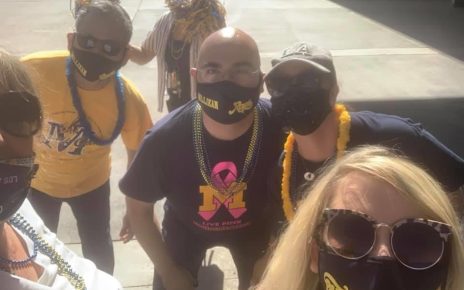The YMCA of Greater Long Beach has locations in East Long Beach, North Long Beach, Lakewood, and Bellflower along with a camp in Big Bear, an Early Childhood Education Center, and a Community Development Center downtown. The YMCA serves more than 50,000 people annually and, as it’s involved in both fitness and education, it’s difficult to imagine many local organizations that have been more impacted by the COVID-19 shutdowns.
YMCA of Great Long Beach Alfredo Velasco said he’s been inspired by the teams within his organization.
“There’s been some silver linings, and one of them is watching our staff mobilize and innovate,” he said.
The YMCA’s gyms were closed in mid-March and, after a brief re-opening, the indoor facilities remain closed. But the YMCA has opened its pools and are offering contactless entrance for RSVP’d lap swims, complete with a temperature check and health screening outdoors. They’ve also moved weightlifting equipment and other functional training devices outside to allow for some traditional “gym workouts.”
The adjustments don’t stop there–they’re also doing classes outdoors under canopies, with yoga, cycling classes, and others taking place in the parking lot now.
Velasco said his organization takes its responsibility to the city’s most vulnerable residents–on both ends of the age spectrum–very seriously.
“We have a lot of homebound active older adults with vulnerable issues,” said Velasco. “For some of our older adults, coming to the Y for swimming or aerobics classes is their only interaction outside of their home that they get in a day or a week.”
One of the ways the local YMCAs quickly switched their operations from running community centers to providing other services was in outreach to older members.
“We mobilized doing food delivery and delivering prescription medications pretty quickly,” said Velasco.
The other immediate pivot was in childcare, as the play rooms that are normally used to provide daycare while parents would use the gyms for an hour or two became much more important locations.
“When the pandemic hit the biggest issue is, ‘How are we going to take care of our kids?’” said Velasco. “First responders, essential personnel, where are their children going with school closed? We started by providing childcare for those workers. We stayed open–we did not shut down one location.”
The YMCA’s staff has also been mobilized to help feed families in Long Beach who are hurting in the wake of an unemployment spike and a challenging economy. The center on Long Beach Boulevard and 9th street has been handing out thousands of meals a day, with a little more than 13,000 meals per week.
“Our Community Development Branch partnered with Food Finders, with Justin Rudd, with Miller Childrens Hospital, with lots of different groups that were right away either delivering food directly or offering drive through pickup,” said Velasco.
One of the other major switches has taken place in the Big Bear mountains, where the YMCA’s Camp Oakes has been converted from a sleepaway camp for children to a scenic nursing home, taking patients off the caseload of Big Bear’s major hospital.
“They wanted to clear space for COVID patients at the hospital,” said Velasco. “So now these patients are at the camp eating in the dining halls, walking around the lake, taking advantage of the camp features.”
The rapidity of the YMCA’s transition of its services doesn’t mean its been a smooth road. They had to furlough a lot of staff immediately after the stay at home order in March, although the stimulus package’s PPE loans allowed them to hire that staff back. There’s also the financial challenges of losing 47% of the YMCA’s gym membership–a statistic that’s actually better than the 65% of gym members who have canceled their memberships nationwide, according to Velasco.
“The fact that we have 53% of our members still with us to support us is a testament to how invested they are,” he said. “We aren’t a swim and gym, we are a hub of family programming.”
Velasco said the biggest challenge has been trying to create programming and strategies in an environment where guidelines change sometimes from hour to hour.
“We’re continually moving,” he said. “It’s challenging–we’re doing what we can, moving into the park, or parking lots. We already had limited facilities and now even when we can be inside it’s cut in half.”
Through all of the changes in society, Velasco said the YMCA is trying hard to keep the emotional needs of the community in mind as well as the physical ones, whether that’s through re-opening swimming lessons for kids or making sure that homebound seniors have some regular contact with the outside world.
“Everything is about bridging to an eventual opening,” he said. “As a family, we can’t go have dinner but we go have a picnic. You do what you can. It’s been a shock for my kids to not see their friends, and I know it’s hard for our community. We’re doing what we can to remain relevant for the community while we bide our time.”





